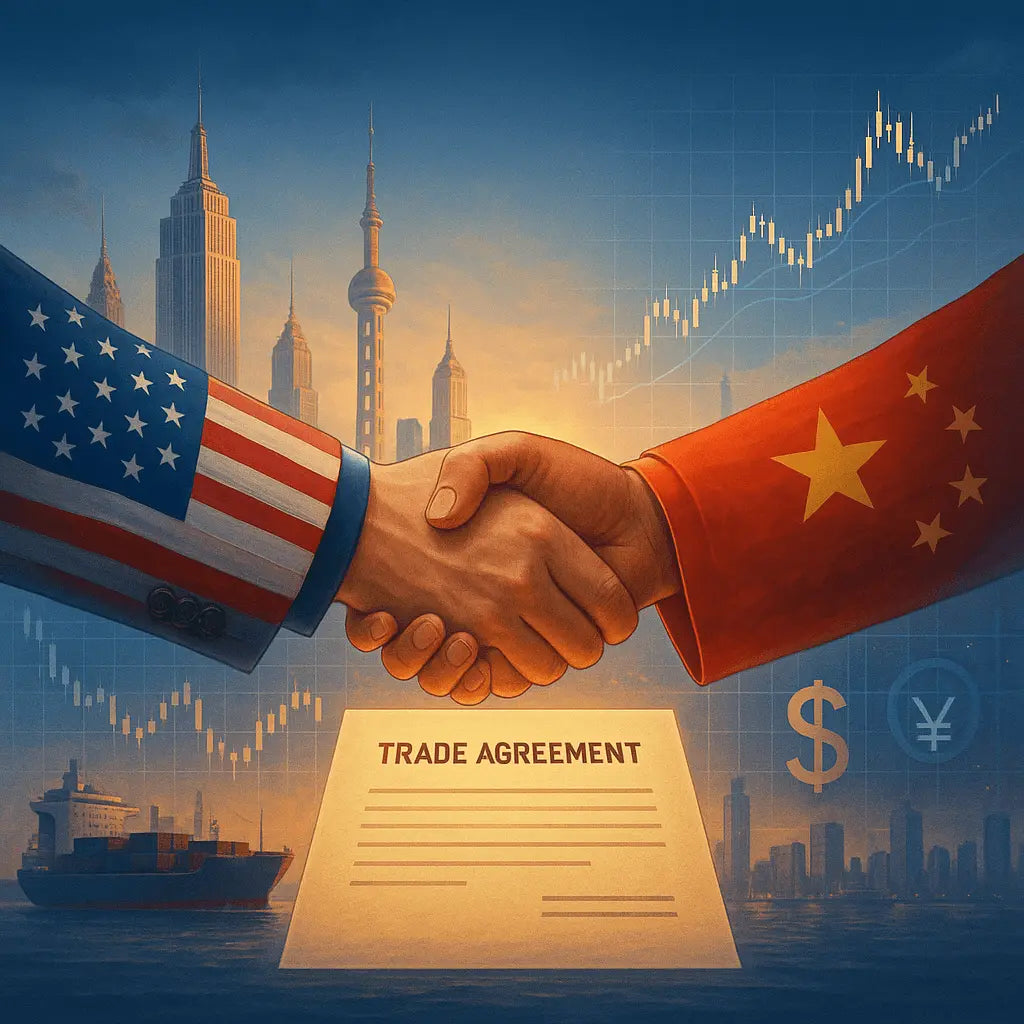On May 12, 2025, in a significant development for the global economy, the governments of the People’s Republic of China ("China") and the United States of America ("U.S.") reached an agreement that could pave the way for more stable and sustainable bilateral economic relations. This agreement, which is set to take effect by May 14, 2025, signifies the importance both countries place on the health of their trade relationship and the global economic stability that such a partnership can foster.
Understanding the Background
The U.S.-China trade relationship is one of the most important in the world, not only for the two countries involved but also for the broader global economy. Over the years, trade tensions have periodically emerged, especially regarding tariffs, trade imbalances, intellectual property rights, and non-tariff barriers. However, both countries have recognized that a sustainable and mutually beneficial economic relationship is crucial for long-term prosperity.
Recent discussions between the two governments focused on resolving some of the most pressing issues in their trade dealings, aiming to create a more balanced and open trade environment. As a result, both parties have committed to taking concrete steps to ease tensions and promote cooperation.
Key Measures Outlined in the Agreement
The agreement centers around two major initiatives that will impact tariffs and non-tariff measures on both sides. Here's a closer look at what the U.S. and China have agreed to do:
-
U.S. Measures:
-
Adjustment of Tariffs on Chinese Goods: Under Executive Order No. 14257, which was issued in April 2025, the U.S. will modify the tariffs imposed on Chinese products, including goods from Hong Kong and Macau. Specifically, the 24% tariff that was initially set to take effect within 90 days will be suspended. However, the remaining 10% tariff on these goods will still apply. This is seen as a step toward reducing the immediate financial burden on Chinese exporters and consumers, while still maintaining a safeguard for U.S. interests.
-
Cancellation of Additional Tariffs: Furthermore, the U.S. will remove the tariffs levied under Executive Orders No. 14259 and No. 14266, which were issued in April 2025. These tariffs were part of an escalating trade dispute but are now being reversed as part of the broader effort to ease trade tensions.
-
-
Chinese Measures:
-
Modification of Tariffs on U.S. Goods: In response to the U.S. tariff changes, China will also adjust its own tariffs on U.S. products. A 24% tariff on U.S. goods will be suspended for an initial 90-day period. The remaining 10% tariff will continue to be imposed, indicating that China still aims to protect its interests while showing a willingness to cooperate. Additionally, China will cancel tariffs imposed under Announcements No. 5 and No. 6 of 2025.
-
Suspension or Cancellation of Non-Tariff Measures: China has also agreed to take necessary steps to suspend or cancel non-tariff retaliatory measures imposed on the U.S. since April 2, 2025. This is seen as an important gesture of goodwill that will help reduce the barriers to trade between the two nations.
-
These actions demonstrate a tangible effort by both governments to resolve their differences, reduce trade friction, and create a more predictable trading environment for businesses in both countries. It also highlights the importance of dialogue and negotiation in addressing global economic challenges.
The Role of Diplomacy and Negotiation
The agreement was reached after extensive discussions between the two countries, demonstrating the power of diplomatic engagement. Both governments recognized that sustainable solutions to trade conflicts require continuous dialogue and collaboration. This agreement was not the result of a sudden decision, but rather the culmination of years of negotiations and back-and-forth discussions aimed at finding common ground.
Both the U.S. and China emphasized the importance of maintaining open communication and respecting each other’s economic sovereignty. This approach, rooted in mutual respect and cooperation, is seen as a significant step toward rebuilding trust and fostering long-term stability in their bilateral trade relations.
The Impact on Global Trade
The U.S.-China economic relationship is closely tied to the broader global economy. Both countries are major players in international trade, and any significant change in their trade policies can have ripple effects around the world. The actions outlined in this agreement are likely to have a positive impact on global supply chains, trade flows, and economic stability.
For example, businesses that rely on the export of Chinese goods to the U.S. or U.S. goods to China will benefit from the reduction in tariffs, which could lower costs for consumers and businesses alike. This will likely improve trade volumes between the two countries and contribute to a more favorable global economic environment.
Moreover, this agreement serves as an important signal to other countries that multilateral negotiations and agreements can work. As the world’s two largest economies demonstrate their ability to resolve trade disputes through dialogue, other nations may be encouraged to adopt similar approaches to address their own economic issues.
The Path Forward: Continued Cooperation and Negotiation
One of the most important aspects of this agreement is the commitment by both sides to continue negotiations on trade and economic issues. A mechanism will be established to ensure ongoing dialogue and the resolution of any remaining concerns. This shows a commitment to a long-term approach to economic cooperation and stability.
The designated representatives for the negotiations are He Lifeng, Vice Premier of China, and Scott Bassett, U.S. Secretary of the Treasury, along with U.S. Trade Representative Jamison Greer. These high-level officials will continue to engage in discussions, either in China, the U.S., or a mutually agreed third country. This ongoing dialogue is essential to ensuring that both parties can address new challenges and adapt to changing global conditions.
Both countries have also acknowledged the need for working-level consultations, which will allow for more detailed discussions on specific issues that affect their bilateral trade relationship. These consultations will be crucial in addressing more granular issues that could arise as the global economic landscape evolves.
The Significance of the Agreement
This agreement is significant for several reasons. First, it reflects a shift in both countries’ approach to trade negotiations. Rather than escalating tensions through punitive measures, both governments are now focused on finding cooperative solutions to their economic challenges. This represents a mature approach to economic diplomacy that could serve as a model for other nations facing similar trade issues.
Second, this agreement demonstrates the importance of flexibility and compromise in international negotiations. By agreeing to modify tariffs and suspend retaliatory measures, both China and the U.S. have shown a willingness to make concessions in the interest of long-term economic stability.
Finally, this agreement highlights the role of government leadership in shaping global economic policies. While businesses and other stakeholders play a key role in global trade, the decisions made by national governments can have a profound impact on the direction of the global economy. As such, this agreement is a testament to the importance of strong leadership in managing international relations and trade.
Conclusion
In conclusion, the U.S.-China trade agreement reached on May 12, 2025, marks a significant step forward in the bilateral relationship between the two countries. By taking concrete actions to modify tariffs and suspend non-tariff retaliatory measures, both governments have demonstrated their commitment to fostering a more stable and mutually beneficial economic relationship.
As the two countries continue to engage in dialogue and cooperation, this agreement serves as a hopeful sign for the future of global trade. It also underscores the importance of diplomacy, negotiation, and compromise in resolving economic disputes, setting a positive example for the rest of the world.
With continued commitment from both sides, the U.S. and China have the potential to build a sustainable and cooperative economic partnership that benefits not only their own citizens but also the broader global community.











Leave a comment
This site is protected by hCaptcha and the hCaptcha Privacy Policy and Terms of Service apply.